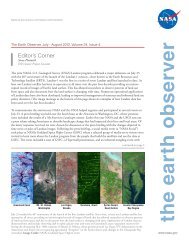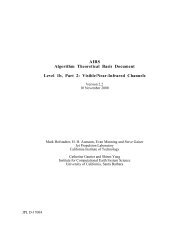MISR: In-Flight Radiometric Calibration and Characterization Plan
MISR: In-Flight Radiometric Calibration and Characterization Plan
MISR: In-Flight Radiometric Calibration and Characterization Plan
Create successful ePaper yourself
Turn your PDF publications into a flip-book with our unique Google optimized e-Paper software.
<strong>In</strong>stitute of St<strong>and</strong>ards <strong>and</strong> Technology (NIST) <strong>and</strong> the National Physical Laboratory of Engl<strong>and</strong>.Detector-based technology avoids the uncertainties associated with the transfer of scale from onesource to another, <strong>and</strong> more importantly, those associated with lamp instabilities which increasewith time. The measure of incident radiance is provided with the st<strong>and</strong>ards, through knowledge oftheir internal quantum efficiency (nearly 100%), filter transmittance, <strong>and</strong> the baffle tube area-solidangle product.For the preflight radiometric calibration, off-the-shelf, high quantum efficiency, trappedlaboratory st<strong>and</strong>ards are utilized. Precision apertures have been added by the <strong>MISR</strong> test team, todefine the fields-of-view for these st<strong>and</strong>ards. A verification has been made by evaluating theprecision of the radiance measurement among the various st<strong>and</strong>ards. Additionally, a round-robinstudy has been conducted in which the participants sequentially viewed the JPL/ <strong>MISR</strong>integrating sphere. Agreement was within 1%, thus giving us confidence in our 3% uncertaintyestimate 1 . Participating were calibration scientists from the Optical Sciences Center, University ofArizona; National Research Laboratory of Metrology (NRLM), the Japanese st<strong>and</strong>ardslaboratory; <strong>and</strong> Goddard Space <strong>Flight</strong> Center (GSFC). Upon completion of the preflight activities,the st<strong>and</strong>ards will be sent to NIST for further verification of the radiometric scale achieved withuse of these st<strong>and</strong>ards.The flight instrument contains an On-Board Calibrator (OBC) which likewise makes useof detector st<strong>and</strong>ards. The radiance scale for these is determined from a transfer of scaleestablished by the laboratory detector st<strong>and</strong>ards, using a small dedicated integrating sphere. Thetie between the preflight <strong>and</strong> in-flight radiometric scale is verified as both the flight <strong>and</strong> laboratorydiodes have an opportunity to view the laboratory integrating sphere. Additionally, the flightdiodes are measured for quantum efficiency, filter transmittance, <strong>and</strong> baffle-tube geometry.<strong>MISR</strong>’s radiometric scale is traceable to NIST <strong>and</strong> other EOS sensors through thereporting of radiances in SI units as accomplished with use of the preflight <strong>and</strong> in-flight detectorst<strong>and</strong>ards, <strong>and</strong> verification of the same.3.3 CALIBRATION EQUATIONEach photoactive pixel element stimulated with incident radiation responds with an outputmeasured in digital numbers (DN). The plot of incident radiance versus DN is termed theradiometric transfer curve. The objective of radiometric calibration is to develop a calibrationequation which best represents the observed radiometric transfer curve, <strong>and</strong> to provide both aquantitative determination of the gain coefficients to this equation, as well as the uncertainties inmeasuring radiances using these coefficients. <strong>Radiometric</strong> calibration is best conducted using afull-aperture (one that overfills the sensor’s field-of-view), spatially <strong>and</strong> spectrally homogeneoussource. Multiple radiometric levels are used, spanning that portion of the sensor dynamic rangethat is of interest to the data community. <strong>Radiometric</strong> uncertainties that arise due to specific scenefeatures (e.g., high contrast targets) are reported as part of the IFRCC characterization program.Sensor gain is primarily a function of the optics transmittance (having a strong field-angledependence), the filter transmittance, CCD quantum efficiency, the amplification of theelectronics <strong>and</strong> the analog-to-digital conversion factor. Local deviations in response are due3. <strong>Calibration</strong> overview22







